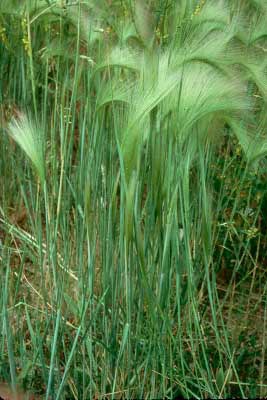Birchleaf Mountain Mahogany

Common Name(s):
Foxtail Barley
Scientific Name:
Hordeum jubatum L.
Scientific Name Synonyms:
None known
Symbol:
HOJU
Description:
Life Span: Perennial
Origin: Native
Season: Cool
Growth Characteristics: A short-lived, perennial bunchgrass without rhizomes, growing 1 to 2 feet tall. It starts growth in late April to May, matures June to August, and reproduces from seeds and tillers.
Seedhead: Nodding, bristly spike up to four inches long; readily breaks apart when mature; three spikelets per rachis node; center spikelet has a single, fertile floret and outside spikelets are small, empty, pedicelled; glumes and lemmas with rough awns up to two inches long, thus the bristly appearance.
Leaves: Glabrous or lower sheaths sometimes pubescent; blades flat, up to 3/8 inches wide and 5 inches long with raised veins on the upper surface; leaves rolled in the bud; ligules short, membranous and collar-shaped; auricles absent.
Ecological Adaptions:
Foxtail barley is found mainly at low to mid elevations, but can sometimes grow up to the subalpine zone. It is native on saline and alkaline meadows. It is one of the few native grasses that can become weedy. Foxtail barley is most often found as a dense band of vegetation in disturbed areas where ephemeral water accumulates, such as near stock water or in reservoir drawdown areas. It also grows at the edges of trampled springs and seeps and in overgrazed pastures.
Foxtail barley is usually found on sites that are moist or flooded in spring, with the surface drying by mid summer with the water table remaining in the upper meter of the soil profile. It can also grow on sites that periodically receive extra moisture such as roadsides and irrigated pastures.
Soils: Foxtail barley grows on a variety of soil types, but is most abundant on poorly drained, wet soils, where textures vary from sandy loams to silty clay loams. It is tolerant of salts and alkali.
Associated Species: Wirerush, redtop, Kentucky bluegrass, arrowgrass, saltgrass, and Basin wildrye.
Uses and Management:
Foxtail barley is low in production and nutritional value, but from spring until the seedhead forms, it is highly palatable to cattle, mule deer, and elk, and moderately palatable to sheep. The mature, dry, stiff seedheads break apart at the nodes, forming sharp pointed joints with long sharp awns which can stick into the nose and mouth of grazers, penetrating the skin. There they can cause infection and sores, often causing "lump jaw" in cattle. Seedheads can also become embedded in the fleece of sheep, dramatically reducing the commercial value of the wool.
Control of foxtail involves efficient irrigation management and grazing management that keeps the preferred species strongly competitive. Avoid letting water stand in low places so long that it drowns out the desirable grass and legume species. Infested pastures should be plowed and reseeded.

